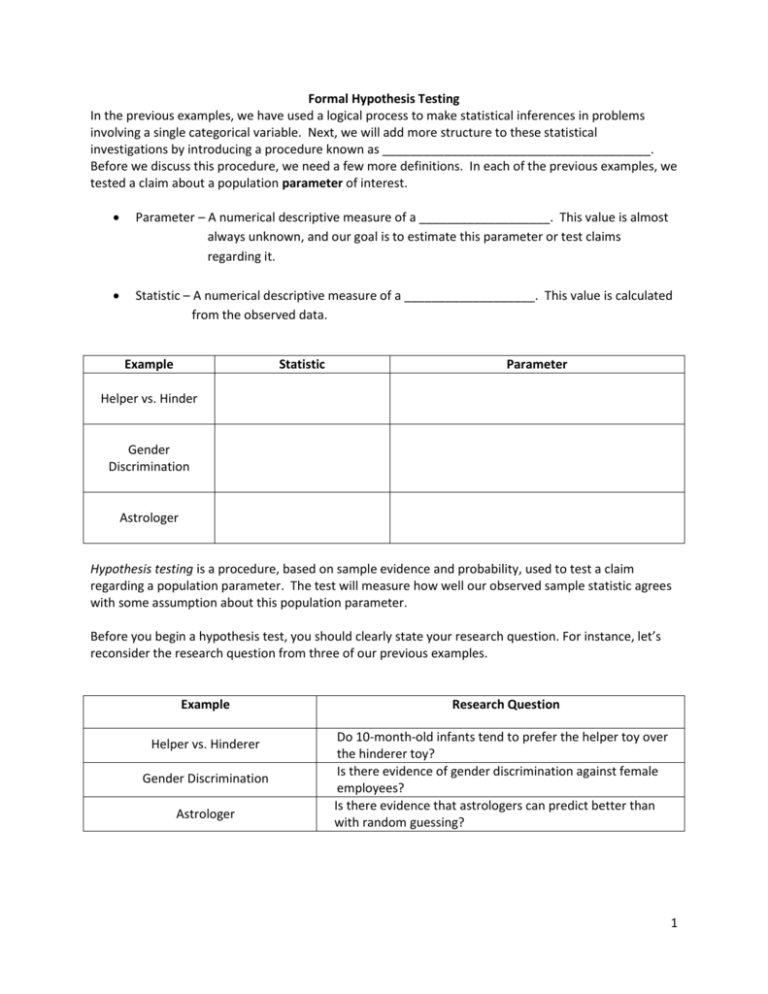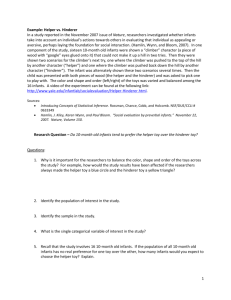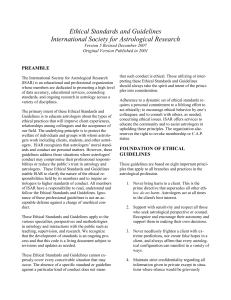Formal Hypothesis Testing In the previous examples, we have used
advertisement

Formal Hypothesis Testing In the previous examples, we have used a logical process to make statistical inferences in problems involving a single categorical variable. Next, we will add more structure to these statistical investigations by introducing a procedure known as _______________________________________. Before we discuss this procedure, we need a few more definitions. In each of the previous examples, we tested a claim about a population parameter of interest. Parameter – A numerical descriptive measure of a ___________________. This value is almost always unknown, and our goal is to estimate this parameter or test claims regarding it. Statistic – A numerical descriptive measure of a ___________________. This value is calculated from the observed data. Example Statistic Parameter Helper vs. Hinder Gender Discrimination Astrologer Hypothesis testing is a procedure, based on sample evidence and probability, used to test a claim regarding a population parameter. The test will measure how well our observed sample statistic agrees with some assumption about this population parameter. Before you begin a hypothesis test, you should clearly state your research question. For instance, let’s reconsider the research question from three of our previous examples. Example Helper vs. Hinderer Gender Discrimination Astrologer Research Question Do 10-month-old infants tend to prefer the helper toy over the hinderer toy? Is there evidence of gender discrimination against female employees? Is there evidence that astrologers can predict better than with random guessing? 1 Setting Up the Null and Alternative Hypothesis The null hypothesis, Ho, is what we will assume to be true, and we will evaluate the observed data from our study against what we expected to see under the null hypothesis. This will always contain a statement saying that the population parameter is equal to some value. The alternative hypothesis, Ha, is what we are trying to show. Therefore, the research question is restated here in the alternative hypothesis. This will always contain statements of inequality, saying that the population parameter is less than, greater than, or different from the value in the null hypothesis. For our three examples, the null and alternative hypotheses are shown below. Research Question Do 10-month-old infants tend to prefer the helper toy over the hinderer toy? Is there evidence of gender discrimination against female employees? Hypotheses Ho: There is no preference for one toy over the other in the population of all 10-month-olds. Ha: The majority of all 10-month-old infants prefer the helper toy. Ho: The selection process is fair. Ha: The selection process is biased against females. Is there evidence that astrologers can predict better than with random guessing? H0: Astrologers are randomly guessing. Ha: Astrologers are able to correctly predict. Note that we can also state these hypotheses in terms of the population parameter of interest: Research Question Hypotheses Ho: Do 10-month-old infants tend to prefer the helper toy over the hinderer toy? Ha: Ho: Is there evidence of gender discrimination against female employees? Ha: 2 Ho: Is there evidence that astrologers can predict better than with random guessing? Ha: Evaluating Evidence Using P-Values In in each of our three examples, we assumed the null hypothesis was true when setting up our spinner for the Tinkerplots investigation. Then, we used the results simulated under this scenario to help us decide whether observing results such as our sample data would be an unusual event if the null hypothesis were true. Up to this point, whether an observed result was considered unusual (or extreme) has been a rather subjective decision. Now, we will discuss the guidelines used by statisticians to determine whether an observed result is extreme enough under the null hypothesis for us to conclude that the evidence supports the research question. Statisticians use what is called a _________________ to quantify the amount of evidence that an observed result from a set of data provides for a research question. P-value – The probability of observing an outcome as __________________ (or more extreme) than the observed study result, assuming the _____ hypothesis is true. Note that in each of the above examples, we obtained the simulation results assuming the null hypothesis was true. Therefore, to estimate the p-value, we simply determine how often outcomes as extreme (or more extreme) than the observed study results appeared in our simulation study. Research Question Do 10-month-old infants tend to prefer the helper toy over the hinderer toy? Is there evidence of gender discrimination against female employees? Is there evidence that astrologers can predict better than with random guessing? Observed Results Outcomes as Extreme p-value 3 Making a Decision with p-values If the p-value is less than ________, then the data provide enough ___________________ evidence to support the research question. If the p-value is ________ less than 0.05, then the data _____________ provide enough statistical evidence to support the research question. Next, we will review the steps involved in a formal hypothesis test for each of our three examples. Note that our conclusions are written in the context of the problem. Moreover, even a person with no statistical background should be able to understand these conclusions (i.e., a conclusion should NOT say something like “We reject the null hypothesis.”) Helper vs. Hinderer Example Research Question – Do 10-month-old infants tend to prefer the helper toy over the hinderer toy? Hypotheses – Ho: There is no preference for one toy over the other in the population of all 10-month olds. Ha: The majority of all 10-month-old infants prefer the helper toy. p-value – Conclusion – Managerial Training Example Research Question – Is there evidence of gender discrimination against female employees? Hypotheses – Ho: The selection process is fair. Ha: The selection process is biased against females. p-value – Conclusion – 4 Astrologer Example Research Question – Is there evidence that astrologers can predict better than with random guessing? Hypotheses – Ho: Astrologers are randomly guessing. Ha: Astrologers are able to correctly predict. p-value – Conclusion – Example: Effectiveness of an Experimental Drug Suppose a commonly prescribed drug for relieving nervous tension is believed to be only 70% effective. Experimental results with a new drug administered to a random sample of 20 adults who were suffering from nervous tension show that 18 received relief. Research Question - Is there statistical evidence that the new experimental drug is more than 70% effective? Questions: 1. Identify both the population and sample of interest. 2. Identify the single categorical variable of interest. 3. Identify both the parameter and statistic of interest. 5 4. Carry out the formal hypothesis test to address the research question. Research Question – Hypotheses – p-value – Conclusion – Example: Obesity in America In 2000 it was reported that 60% of Americans were categorized as overweight or obese. According to recent studies it appears that even more Americans are now categorized as overweight or obese. A random sample of 125 Americans was taken and 83 of them were categorized as overweight or obese. I Research Question – Is there evidence that the obesity rate of Americans has increased since 2000? Questions: 5. Identify both the population and sample of interest. 6 6. Identify the single categorical variable of interest. 7. Identify both the parameter and statistic of interest. 8. Carry out the formal hypothesis test to address the research question. Research Question – Hypotheses – p-value – Conclusion – 7











